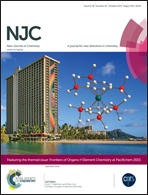Application of the energetic span model to the electrochemical catalysis of proton reduction by a diiron azadithiolate complex†
Abstract
Computational methods, such as DFT calculations, have emerged as a powerful tool to study the homogeneous catalysis of electrochemical reactions involved in renewable fuel production. Here, we report an adaptation of the energetic span model to obtain, from DFT calculations, key metrics of the catalysis of electrochemical H2 production by the diiron azadithiolate complex [Fe2(μ-SCH2NHCH2S)(CO)6] (1). The main advantage of our approach is that both thermodynamic and kinetic effects on the turnover frequency (TOF) can be computed in a simple way. By taking into account the influence of the electrode potential on TOF determining intermediates (TDI) and TOF determining transition states (TDTS), we calculated a TOF vs. overpotential relationship that shows three different kinetic regimes. This finding is consistent with the catalytic mechanism derived from the analysis of voltammetric responses of 1 in the presence of tosic acid.


 Please wait while we load your content...
Please wait while we load your content...